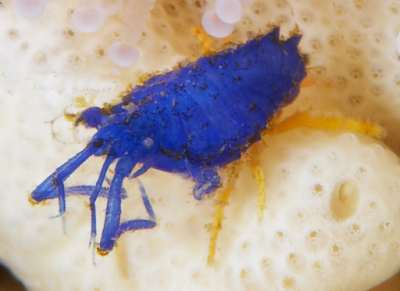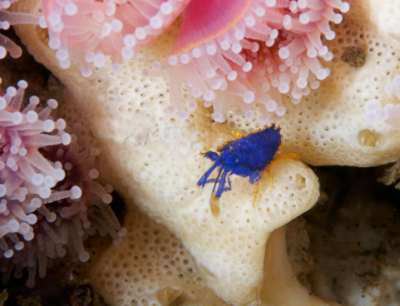Amphipod crustacean mimic (Southern California)
February 4, 2006
From: Matt Segal

On a recent dive in Southern California (Anacapa Island), I came across the following amphipod crustacean, and after running it by a few people that I know, found that it was a Podocerus cristatus (thank you to Leslie Harris and Don Cadien for the ID).
Locality: Backside of Anacapa Island, California, USA. Depth: 25 ft. Length: 6 mm body, ~10 mm w/ front legs. 28 January 2006. High-surge outcrop. Photographer: Matt Segal
I knew that this species had been linked as a mimic amphipod on this website [message #2641] and [message # 2608], but I am curious as to what nudibranch species this colour form would mimic (notice that its legs are bright yellow in contrast to its body), and what substrate is it supposed to live on?
Thanks in advance.
Matt Segal
mattsegal@carbonos.com
Segal, M.J., 2006 (Feb 4) Amphipod crustacean mimic (Southern California). [Message in] Sea Slug Forum. Australian Museum, Sydney. Available from http://www.seaslugforum.net/find/15713
Dear Matt,
I didn't realise this amphipod had so many different colour forms. Just because two animals are very similarly coloured it does not mean they are mimics in the evolutionary sense of the word. Evolutionary mimics are two species - or one species and a model - which have gradually through evolutionary changes grown to look alike. It is possible that lookalikes can also evolve quite by chance. I don't even know if there are any studies to show that the two examples you mention from the Forum are really true mimics. So even if there are blue and yellow animals from California which look extremely similar to this colour form of the amphipod, it does not necessarily follow that one ins mimicking the other.
Best wishes,
Bill Rudman
Related messages
-
Re: Another goby on nudibranch
From: Andy Eastwood, February 11, 2009 -
Ceratosoma with Periclimenes imperator
From: Corby James, September 17, 2005 -
Commensalism in Californian nudibranchs
From: James Lyle & Leslie Harris, July 30, 2005 -
Amphipod commensal on Tritonia festiva
From: James Lyle & Leslie Harris, July 30, 2005 -
Another commensal scaleworm
From: James Lyle & Leslie Harris, July 30, 2005 -
Re: Another goby on nudibranch
From: Bill Rudman, July 11, 2005 -
Another goby on nudibranch
From: Jerry Allen, July 5, 2005 -
Commensal fish on Ceratosoma trilobatum
From: John Weinberg, June 27, 2005 -
Chromodoris coi with copepod
From: Fredy Brauchli, March 22, 2004 -
Mystery mark on Risbecia pulchella
From: Stephanie Maleady, January 25, 2004 -
It's a puzzle
From: Mary Jane Adams, May 10, 2002 -
Symbiotic stress
From: Ali, April 10, 2002 -
Ceratosoma trilobatum with commensal shrimp
From: Mary Jane Adams, September 21, 2001 -
Mutualism and symbiosis
From: Lindsay Jennings, January 24, 2001 -
Examples of Symbiosis
From: Sutha, August 23, 2000 -
Commensalistic Symbiosis
From: Josh Williamsen, March 24, 2000 -
Examples of endoecism
From: Sonia, December 9, 1999 -
Nudibranch with commensal shrimp
From: Erik Schloegl, November 14, 1999 -
Slugs and Microbes
From: Daniel Vega Mendoza, June 5, 1999 -
Information about commensalism
From: Kara Hailey, February 20, 1999 -
Commensalism
From: Kerry, January 18, 1999 -
Parasite and Mutualistic relationships
From: Tammy Pearson, November 21, 1998 -
"Commensalistic symbiosis"
From: Laura, October 30, 1998 -
symbiosis
From: unidentified enquirer, October 25, 1998 -
Symbiosis and commensalism
From: , March 28, 1998
